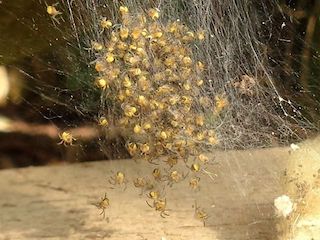 In late summer and early autumn, you may notice orb spiderwebs covering the shrubs and long grass alongside the coastal paths on the Lizard, glistening with dew in the early morning. They will have been made by the Garden Spider, common in Cornwall.
In late summer and early autumn, you may notice orb spiderwebs covering the shrubs and long grass alongside the coastal paths on the Lizard, glistening with dew in the early morning. They will have been made by the Garden Spider, common in Cornwall.
Photo: Ilya Maclean
Scientific name: Araneus diadematus
Other common names: Garden Cross Spider, Diadem Spider, Cross Orbweaver, Garden Orb-web Spider, European Garden Spider
Cornish name: Kevnisen is the general word for a spider
The orb web of the Garden Spider is a familiar sight across the country. Widely distributed around the northern hemisphere, the beautifully structured webs of this common spider appear from later summer to early autumn, sparkling with dew and catching the rays of the lower autumn sunlight in the early morning. Along country paths, in woods and gardens, across heathland and many other habitats, the large webs can cover the hedgerows and longer grasses.
Garden Spiders have a range of colouration, from pale sandy yellow to shades of red and even darker browns, but all belong to the same species, and can be identified by the distinctive white cross marking on their upper abdomen.
The webs, which can be up to 40 cm across, have of course the purpose of trapping the spiders’ food of flies and other insects. The spider sits in centre of its web, using its pair of long front legs to detect vibrations as potential prey lands on the sticky silk.
 Females, as in many spider species, are larger (up to 15 mm) than the males (up to 9 mm). Both sexes become mature in high summer to early autumn (this is why the webs appear at this time of year). After mating, a female will swell in size as the eggs develop, before she finally lays them (from 300 to 800 yellow eggs), cementing them into an egg sac formed of a coarse layer spun from her silk and incorporating detritus. She then stays close by to protect them and, as she is not able to leave to hunt for food, she dies in later autumn. The tiny spiderlings, yellow with a black spot at their rear end, emerge in the following May. They intially stay close together in a bundle, but if disturbed they will ‘explode’ away on silken threads, before coming back together once they feel safe again. They ultimately leave the egg sac on silken threads, and are dispersed by the wind (known as ‘ballooning’). It takes two years for the young spiders to reach full breeding maturity.
Females, as in many spider species, are larger (up to 15 mm) than the males (up to 9 mm). Both sexes become mature in high summer to early autumn (this is why the webs appear at this time of year). After mating, a female will swell in size as the eggs develop, before she finally lays them (from 300 to 800 yellow eggs), cementing them into an egg sac formed of a coarse layer spun from her silk and incorporating detritus. She then stays close by to protect them and, as she is not able to leave to hunt for food, she dies in later autumn. The tiny spiderlings, yellow with a black spot at their rear end, emerge in the following May. They intially stay close together in a bundle, but if disturbed they will ‘explode’ away on silken threads, before coming back together once they feel safe again. They ultimately leave the egg sac on silken threads, and are dispersed by the wind (known as ‘ballooning’). It takes two years for the young spiders to reach full breeding maturity.
Did you know…?
…The Garden Spider weaves its web overnight, spinning silk from the three pairs of spinnerets at the end of its abdomen, ready for the following day. This is why if you destroy a web in your garden on one day, you will find it back there the next morning. The spider consumes its old web in order to conserve the proteins used to make the silk.
…If you see one of these spiders shaking its web, or falling to the ground using one of its silk threads, this is because it is feeling threatened.
Published: September 2013 (updated May 2020)
Author: Amanda Scott (with additional information on spiderlings from Debbie Sea-Kay)
Photos: Ilya Maclean (adult spider in web); Debbie Sea-Kay (spiderlings)
